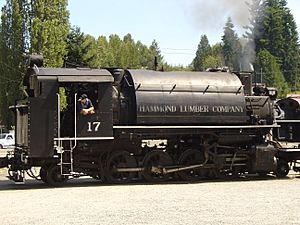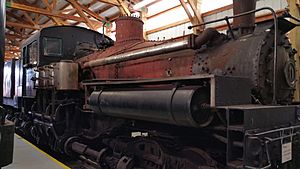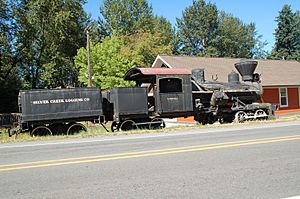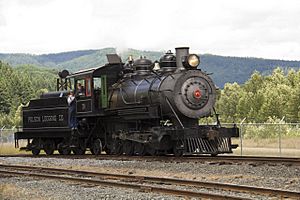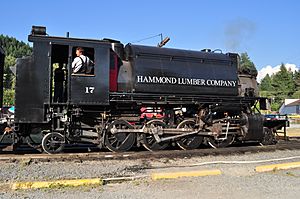Mount Rainier Railroad and Logging Museum facts for kids

A view of Mount Rainier from the railroad line
|
|
| Overview | |
|---|---|
| Headquarters | Elbe, Washington |
| Locale | Lewis & Pierce counties, Washington, U.S. |
| Dates of operation | 1980–2020 |
| Technical | |
| Track gauge | Standard 1,435 mm (4 ft 8 1⁄2 in) |
| Length | 7 miles (14 miles round-trip) |
The Mt. Rainier Railroad and Logging Museum (MRRR) was a special train line. It used old steam engines. This railroad was also known as the Mt. Rainier Scenic Railroad (MRSR). It ran in the state of Washington, in the U.S.. The train traveled between the towns of Elbe and Mineral.
The tracks went through thick forests. These forests are just south of Mount Rainier. You could buy tickets and find a gift shop in Elbe. The train would then take you to the Logging Museum in Mineral. The MRRR used its collection of old train equipment. It ran on seven miles of track. This track is part of Tacoma Rail's Mountain Division.
The railroad had three steam locomotives. It also had a diesel locomotive that ran regularly. Many other engines were also part of its collection. Most of the railroad's engines were "geared steam locomotives." These are special types of steam engines. They include Shay locomotives, Heisler locomotives, Climax locomotives, and a Willamette locomotive.
These engines were used in the early 1900s for logging. Logging means cutting down trees for wood. Geared locomotives were better than regular steam engines. They could handle steep hills, sharp turns, and bumpy tracks. These tracks were often quickly built for logging. The MRRR wanted to save and run these old geared locomotives. This helped visitors understand the logging history. It was a very important part of how the Pacific Northwest grew.
Before 2016, volunteers mostly ran the steam trains. They made up most of the railroad's staff. But in 2016, American Heritage Railways bought the railroad. After that, professional staff ran the trains. The MRRR usually ran on weekends. This was from Memorial Day to late October. They also had special "Polar Express" trains in November and December. In May 2020, American Heritage Railways announced bad news. The railroad would stop running. This was because of money problems from the COVID-19 pandemic.
History of the Railroad
The MRRR used tracks that started in Tacoma. These tracks were built over 100 years ago. In 1887, the Hart brothers built a short, narrow train line. It started at 46th Street in Tacoma, Washington. In 1890, a new group took over the railroad. They called it the Tacoma Eastern Railroad. They changed the tracks to a wider "standard gauge." They also made the tracks longer by six miles.
In 1900, new investors bought the railroad. They had money interests near Elbe. This was in the Nisqually Coal Fields. So, they wanted to extend the Tacoma Eastern. They wanted it to reach the area where the MRRR runs today. The route was also extended to reach large forests. These forests were south of Mount Rainier. The tracks eventually reached Morton.
Even though it was called Tacoma Eastern, big investors controlled it. These investors were far from the Pacific Northwest. The Chicago, Milwaukee, St. Paul and Pacific Railroad (the "Milwaukee Road") controlled it early on. This was as early as 1901. In the 1890s, the Milwaukee Road wanted a train connection. They wanted to link the Midwest to the Pacific coast. The Tacoma Eastern was a good choice for them.
The Tacoma Eastern stayed a part of the Milwaukee Road. It was owned through stock. In 1918, the United States Railroad Administration took over. They combined all of Milwaukee Road's smaller lines. The Tacoma Eastern became known as the National Park branch. This part of the Milwaukee Road was very profitable. It made a lot of money. Because of this, it was saved when the Milwaukee Road went bankrupt in 1980.
The Tacoma Eastern continued to carry lumber. This lumber came from forests owned by the Weyerhaeuser Corporation. Weyerhaeuser's lands still surround the MRSR today. They still use the line for shipping wood.
After the Milwaukee Road went bankrupt in 1980, Tom Murray, Jr. wanted to open part of the line for tourists. He was a lumberman from Tacoma. So, he created the MRSR. He wanted to run old train equipment stored in Tacoma. The Weyerhaeuser Corporation let the MRSR use seven miles of track. This was from Elbe to Mineral.
Weyerhaeuser owned the track until 1998. Then, they gave control of their rail lines to the City of Tacoma. This became Tacoma Rail. This change did not affect the MRSR. It still ran its tourist trains. The route was also still open for shipping wood. In mid-2016, the MRSR was sold. American Heritage Railways bought it. They also own the famous Durango and Silverton Narrow Gauge Railroad. They renamed the MRSR to the Mount Rainier Railroad and Logging Museum.
Locomotives of the Railroad
The Mt. Rainier Railroad had many different locomotives. Here are some of the main ones:
| Number | Builder | Type | Built | Acquired | Image | Description | |
|---|---|---|---|---|---|---|---|
| No. 2 | Willamette Iron and Steel Works | 3-truck geared steam locomotive | 1929 | 2002 |
|
This engine was built for a lumber company. It is the only Willamette engine still running in the world. It is currently operable. | |
| No. 10 | Climax Locomotive Works | 3-truck Climax | 1928 | 1979 | This was one of the last Climax engines ever built. It was the first steam engine to run on the MRSR. It is stored inoperable. | ||
| No. 11 | Lima Locomotive Works | 3-truck "Pacific Coast" Shay | 1929 | 1981 | This is one of only five "Pacific Coast" Shays left. It is stored inoperable. | ||
| No. 91 | Heisler Locomotive Works | 3-truck "West Coast Special" Heisler | 1930 | 1980 | This engine was donated to the museum. It was renamed No. 91 to honor another engine. It is stored inoperable. | ||
| ? | Heisler Locomotive Works | ? | 1912 | ? |
|
This engine is on display near the Elbe train station. It is on display. | |
| No. 70 | Baldwin Locomotive Works | 2-8-2 | 1922 | 1992 |
|
This engine was bought from Rayonier Corp. It was restored in 2011 and again in 2017. It is currently operable. | |
| No. 45 | Baldwin Locomotive Works | 2-6-2 | 1906 | 1998 | This engine was also bought from Rayonier Corp. It has been sold to a private owner. It is stored Inoperable. | ||
| No. 5 | H.K. Porter, Inc. | 2-8-2 | 1924 | Early 1980s | This was one of the largest Porter engines ever built. It was a main engine for the MRSR until 2003. It is stored inoperable. | ||
| No. 17 | American Locomotive Company | 2-8-2T | 1929 | 1980 |
|
This engine was bought by MRSR in 1980. It ran from 1995 to 2011. It returned to service in 2013. It is currently operable. | |
| No. 481 | General Motors Electro-Motive Division | EMD NW2 Diesel-electric | 1942 | 2001 | This diesel engine was built for the Great Northern Railway. It is stored inoperable. | ||
| No. 7012A | General Motors Electro-Motive Division | EMD F9 Diesel-electric | 1956 | 1982 | This diesel engine was built for the Northern Pacific Railway. It is currently operable. | ||
| No. 41 | American Locomotive Company | ALCO RSD-1 Diesel-electric | 1941 | This engine was damaged by a fire. It is stored inoperable. | |||
| No. 42 | American Locomotive Company | ALCO S-1 Diesel-electric | This engine is stored inoperable. |
All of the railroad's engines were fixed and cared for at the shops in Mineral, Washington.


